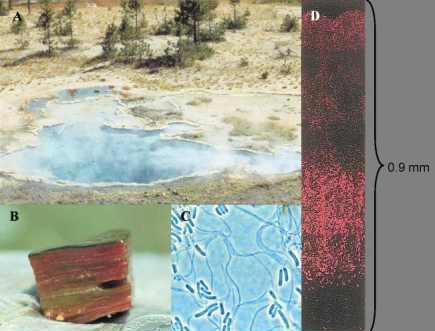Introduction
|
My students and I have studied hot spring microbial mat communities in Yellowstone National Park since 1977 (Fig. 1). We study them as models of microbial community ecology addressing primarily questions about the composition, structure and function of the community. Microscopically, it appears that that community structure is simple: a single, sausage-shaped cyanobacterium (Synechococcus sp. revealed by the red autofluorescence of the chlorophyll a they contain) appears to build the community together with filamentous bacteria resembling green nonsulfur bacteria (Chloroflexus sp.). This simple picture of community structure was reinforced by the fact that readily cultivated Synechococcus andChloroflexus strains appeared to have limited genetic diversity, as expected of single species. Since I was a graduate student I have been concerned that the simple morphology of microorganisms might mask an underlying greater diversity. Furthermore, I doubted that the extremely selective nature of laboratory cultivation techniques would make it useful for describing the composition of microbial communities in an unbiased way. In 1984 I took a sabbatical leave with Norman Pace to learn molecular methods for cultivation-independent analysis of diversity within a microbial community. As a result, we have been able to develop approaches to demonstrate that this community is not as simple as it first appears. |
Figure 1. Green hot spring microbial mats occur below ca. 74°C (a). The top green layer (b) is comprised of filamentous green nonsulfur-like bacteria and unicellular cyanobacteria, Synechococcus (c) that form distinct layers of different autofluorescence intensity in the top 1 mm (d). |

